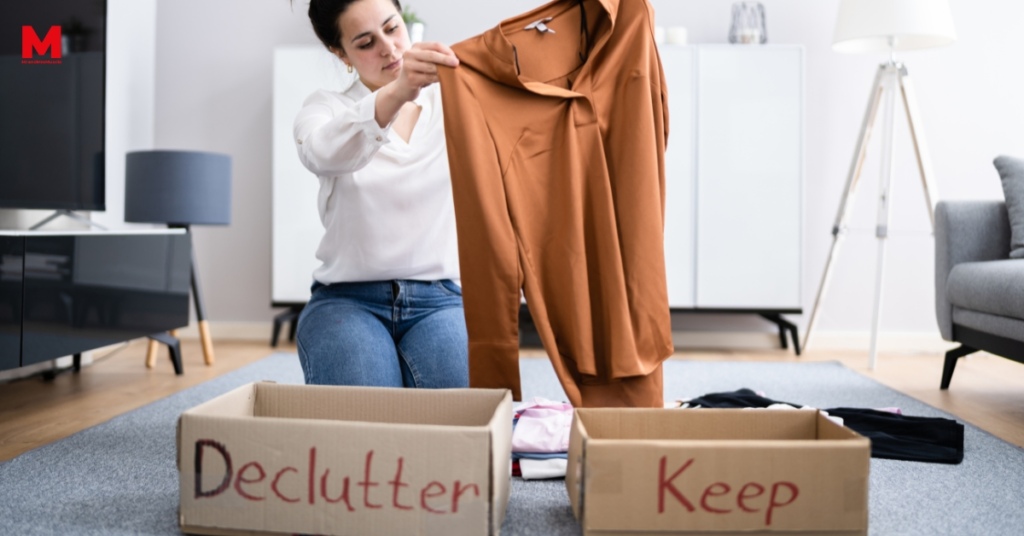Are you feeling overwhelmed by the clutter in your life? Do you feel like it’s taking away from your ability to focus and enjoy your life? If so, you’re not alone. The process of decluttering can be overwhelming, but it can also be extremely rewarding. In this blog post, I’m going to give you a 5-step guide to declutter your life and make space for what truly matters. By the end of this post, you’ll have a clear plan for how to let go of the things that don’t serve you and make room for the things that do. So let’s get started!
Why decluttering is important?
Decluttering is not just about having a tidy and organized space; it is about creating a more balanced and fulfilling life. When our physical surroundings are cluttered, it can have a negative impact on our mental and emotional well-being.
Firstly, decluttering helps to reduce stress and overwhelm. When we are surrounded by excess stuff, it can be mentally exhausting to constantly be searching for things or trying to navigate through cluttered spaces. By decluttering and creating a more organized environment, we can alleviate some of that mental strain and create a more peaceful atmosphere.
Secondly, decluttering allows us to prioritize what is truly important to us. When we have too many belongings, it becomes difficult to appreciate and value each individual item. By decluttering and letting go of things that no longer serve us, we can focus on the items that truly bring us joy and meaning.
Furthermore, decluttering can have a positive impact on our productivity and creativity. Clutter can be distracting and hinder our ability to focus and be efficient. By creating a clutter-free environment, we can free up mental and physical space to better pursue our goals and passions.
Step 1 - Assessing your belongings
Before embarking on a decluttering journey, it’s essential to assess your belongings and get a clear understanding of what you own. This step might seem daunting, but it’s crucial to make decluttering efficient and effective.
Here’s how to assess your belongings:
- Take inventory: Go room by room and create an inventory of all your possessions. This includes clothing, furniture, books, and other household items.
- Evaluate their usefulness: Consider how frequently you use each item and if it serves a purpose in your life.
- Identify duplicates: Do you own multiple items that serve the same purpose? If so, consider keeping only one.
- Recognize sentimental items: Sentimental items hold emotional value, and it can be hard to let go of them. Identify which ones are genuinely meaningful to you.
- Note their condition: Take note of the condition of each item. Are they damaged or beyond repair? Do they require maintenance?
By assessing your belongings, you can get a clearer picture of what you own and what needs to go. Remember, decluttering is a process that requires patience and time, but it’s worth it. The more you let go of unnecessary possessions, the more room you have for things that bring you joy.
Step 2 - Creating categories for your items
Now that you have assessed your belongings, it’s time to create categories for your items. This will make sorting through your items a lot easier and less overwhelming.
Here are some categories to consider:
- Keep: Items that you use regularly and are necessary for your everyday life.
- Sell: Items that are still in good condition and could fetch a good price if sold.
- Donate: Items that are still usable but no longer serve a purpose in your life. Consider donating them to a local charity or shelter.
- Toss: Items that are broken or no longer functional and cannot be repaired.
- Sentimental: Items that hold emotional value to you, such as photographs or keepsakes.
Be sure to take your time and really consider each item when creating categories. Some items may be hard to categorize, but it’s important to make the best decision for your lifestyle and needs. Next, move on to sorting through your items and deciding what to keep, sell, donate, or toss.
Step 3 - Sorting through your items
Now that you’ve created categories for your items, it’s time to start sorting through them. This can be the most time-consuming part of the decluttering process, but it’s also the most crucial. You’ll need to be decisive, but also compassionate with yourself as you go through your belongings.
Here are some tips to help you sort through your items:
Start with the easy items first
– It’s a good idea to start with the items that are easy to make decisions about. This could be clothes that don’t fit, items that are broken or no longer needed, or things that you know you haven’t used in a long time.
Be honest with yourself
– When sorting through your items, it’s important to be honest with yourself about whether or not you actually need them. Don’t hold onto something just because you think you should or because you feel guilty about getting rid of it.
Consider your lifestyle
– As you go through your belongings, think about your current lifestyle and what you really need. If you’ve recently downsized, you may need to get rid of some items that no longer fit in your space. Or, if you’ve started a new hobby, you may need to make room for the new equipment or supplies.
Ask for help
– If you’re struggling to make decisions about certain items, consider asking for help from a friend or family member. They can offer an objective perspective and may be able to help you make tough decisions.
By taking the time to sort through your belongings, you’ll be able to make more informed decisions about what to keep and what to get rid of. It’s important to be patient with yourself throughout this process, but the end result will be a more organized and clutter-free home.
Step 4 - Deciding what to keep, sell, donate or toss
Now that you’ve sorted through your belongings and created categories for them, it’s time to decide what to keep, sell, donate, or toss. This can be a difficult step for many people, but it’s important to remember that decluttering is all about letting go of things that no longer serve a purpose in your life.
When deciding what to keep, ask yourself if the item brings you joy or if it’s something you use on a regular basis. If the answer is yes, then it’s worth keeping. However, if the item doesn’t serve a purpose or has been collecting dust, it’s time to let it go.
If you have items that are in good condition but you no longer need, consider selling them online or at a garage sale. This can help you earn a little extra money and give your items a second life.
For items that are still in good condition but aren’t worth selling, consider donating them to a local charity or organization. This can help someone in need and make you feel good about decluttering your space.
Finally, for items that are broken, worn out, or just plain unusable, it’s time to toss them. This may be difficult for some people, but remember that keeping clutter around can be more stressful in the long run. Letting go of things that no longer serve a purpose can be liberating and help you live a more organized life.
Step 5 - Organizing and storing your remaining items
Once you have decided what items to keep after sorting through your belongings, it’s time to focus on organizing and storing them effectively. This step is crucial to maintaining a clutter-free and organized life.
Here are some tips to help you with this process:
- Invest in storage solutions: Purchase storage containers, bins, shelves, or organizers that suit your needs. Opt for transparent or labeled containers to easily identify what is inside.
- Create designated spaces: Assign specific areas or zones for different categories of items. For example, designate a space for books, another for clothes, and another for kitchen utensils. This will make it easier for you to find things when you need them.
- Maximize vertical space: Utilize the vertical space in your home by installing shelves or utilizing wall-mounted storage solutions. This will help you make the most of the available space and keep your belongings organized and easily accessible.
- Use drawer dividers: Drawer dividers are a great tool to keep smaller items like jewelry, stationery, or makeup organized. They prevent items from getting mixed up and help maximize the use of space within the drawer.
- Label everything: Labeling containers and shelves will help you quickly identify where specific items are stored. It also makes it easier for others to find things when needed.
By following these steps and implementing effective organizing and storage solutions, you can ensure that your remaining items are well-organized and easy to access. This will contribute to a more clutter-free and organized life, allowing you to enjoy the benefits of a streamlined and peaceful living environment.
Summary
Decluttering can be a challenging but rewarding process. By following the 5 steps outlined in this guide, you can transform your home and your life. Remember to take the time to assess your belongings, create categories, sort through your items, decide what to keep, sell, donate or toss, and finally, organize and store what remains. Embrace the art of letting go and discover the joy that comes from a more organized and simplified life. Start today and reap the benefits of a clutter-free space!


